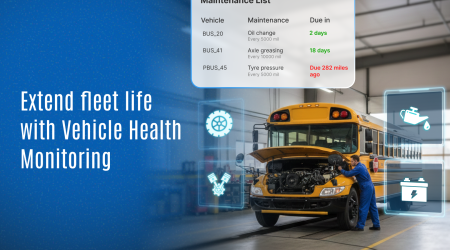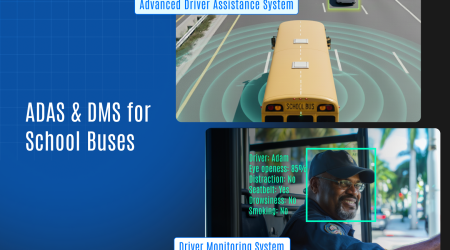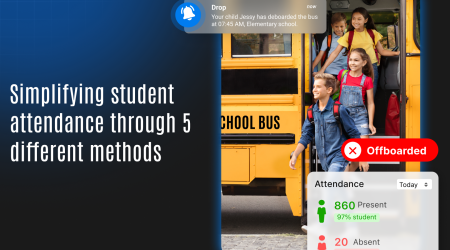Leveraging Advanced Analytics for Improved Operations in School Transportation

In today’s fast-paced world, schools face various challenges, from ensuring student safety to optimizing operational efficiency. Let’s consider a school which has turned to advanced analytics to tackle these issues head-on, especially in the realm of school bus monitoring in concern with the school transportation. This case study delves into how the school leverages advanced analytics for improved operations, ensuring a safer and more efficient environment for their students and staff.
Introduction to Advanced Analytics in School Operations
The advent of advanced analytics has revolutionized multiple sectors, and education is no exception. At the school, the integration of sophisticated data analytics tools has transformed how they manage day-to-day operations. From tracking bus routes to monitoring student attendance, advanced analytics provide insights that were previously unattainable. The focus of this case study is on how these schools utilize advanced analytics in their school bus monitoring software to enhance operational efficiency and student safety.
Why Advanced Analytics Matter
Before diving into the specifics, it’s crucial to understand why advanced analytics are vital for school operations. These analytics enable schools to:
Enhance Safety:
By providing real-time data on bus locations, speeds, and driver behavior, schools can ensure the safety of students during transit.
Real-Time Data:
Advanced analytics tools provide live updates on the location and speed of school buses, allowing school administrators to monitor their fleet’s movement at all times. This means that if a bus goes off-route or faces any issues, immediate actions can be taken to rectify the situation.
Driver Behavior:
Monitoring driver behavior such as speed, braking patterns, and adherence to routes helps in identifying unsafe practices. This data can be used to train drivers better, ensuring that all safety protocols are followed.
Incident Response:
In case of emergencies or accidents, real-time data helps in providing prompt assistance and accurate information to first responders, ensuring student safety is prioritized.
- Optimize Routes: Analytics can identify the most efficient bus routes, saving time and fuel costs.
- Traffic Patterns: By analyzing historical traffic data, advanced analytics can suggest the best routes that avoid traffic congestion, thus reducing travel time.
- Fuel Efficiency: Strategic route planning not only conserves time but also diminishes fuel usage, resulting in considerable savings on costs. This is crucial for schools operating on tight budgets.
- Environmental Impact: Optimized routes contribute to lower emissions, supporting environmental sustainability initiatives within the school district.
- Monitor Attendance: Automated attendance tracking through bus systems helps in managing student data accurately.
- RFID Technology: Using RFID tags, the system can track when and where students board and exit the bus. This provides an accurate and automated way of tracking student attendance.
- Data Accuracy: Automated systems reduce the chances of human error in attendance records, ensuring that the school always has up-to-date and accurate data.
- Parental Notifications: Parents can receive notifications about their child’s attendance, providing them with peace of mind about their child’s whereabouts.
- Enhance Communication: Instant alerts and updates keep parents and school administrators well-informed about bus timings and any delays.
- Mobile Apps: Dedicated mobile applications for parents allow them to track the real-time location of the bus, so they know exactly when to expect their child home.
- Alerts and Notifications: Automated alerts about delays, route changes, or any incidents ensure that parents and administrators are always in the loop, improving overall communication and trust.
- Crisis Management: In case of emergencies, instant communication channels help in disseminating information quickly and accurately, ensuring all stakeholders are informed.
Implementing School Bus Monitoring Software
At the heart of the school operational strategy is their advanced school bus monitoring software. This software integrates GPS technology with real-time data analytics to offer comprehensive monitoring and management of school transportation systems. Here’s how it works:
- Real-Time Tracking: The software provides live tracking of all school buses, allowing administrators to monitor their exact location at any given moment. This helps in ensuring that buses are following their designated routes and schedules.
- Driver Behavior Monitoring: Advanced analytics assess driver performance by monitoring speed, braking patterns, and adherence to designated routes. This data helps in identifying and addressing unsafe driving practices.
- Route Optimization: By analyzing traffic patterns and historical data, the software suggests the most efficient routes, reducing travel time and operational costs.
- Safety Alerts: Automated alerts notify school officials and parents about any deviations from the planned route or any incidents during transit.
Case Study: The School Success with Advanced Analytics
To illustrate the impact of advanced analytics on the school operations, let’s delve into a specific scenario:
Scenario: Enhancing Student Safety
Problem: The school were facing challenges in ensuring the safety of students during transit. Incidents of buses deviating from their routes and delays were common concerns among parents and administrators.
Solution: The school implemented a sophisticated school bus monitoring software that utilized advanced analytics to provide real-time tracking and monitoring of all school buses.
Outcome: The implementation led to a significant reduction in route deviations and delays. Parents received real-time notifications about bus arrivals and any delays, enhancing their confidence in the school’s transportation system. Moreover, the software’s driver behavior monitoring feature helped in identifying and addressing unsafe driving practices, further ensuring student safety.
Detailed Outcome:
- Reduction in Deviations: By monitoring the real-time location of buses, The school were able to ensure that drivers adhered to their assigned routes. Any deviation was immediately flagged, allowing for quick corrective action.
- Parental Confidence: Real-time notifications about bus arrivals and delays helped in building trust with parents. Knowing that they could track their child’s bus and receive updates in real-time reassured them about their child’s safety.
- Improved Driver Behavior: The driver monitoring feature allowed the school to identify patterns of unsafe driving. This data was used to conduct targeted training sessions for drivers, emphasizing the importance of safety protocols.
Scenario: Optimizing Bus Routes
Problem: Inefficient bus routes were leading to increased fuel costs and longer travel times for students.
Solution: The school bus monitoring software analyzed historical data and traffic patterns to suggest optimized routes.
Outcome: The school managed to reduce their fuel expenses by 15% and cut down the average travel time for students by 20%. The optimized routes also contributed to lower emissions, supporting the school’s sustainability goals.
Detailed Outcome:
- Fuel Savings: By optimizing bus routes, the school reduced unnecessary travel and idling time, leading to a 15% reduction in fuel expenses. This not only saved money but also helped in allocating resources more efficiently.
- Reduced Travel Time: The optimized routes ensured that students spent less time on the bus, reducing their daily commute by an average of 20%. This was particularly beneficial for students living far from the school, allowing them more time for studies and extracurricular activities.
- Environmental Benefits: The reduction in fuel consumption contributed to lower carbon emissions, aligning with the school’s commitment to environmental sustainability.
Key Features of Advanced School Bus Monitoring Software
The success of the school can be attributed to several key features of their advanced school bus monitoring software. Here are some of the most significant ones:
- Geofencing: This feature creates virtual boundaries around specific areas, such as school premises and bus stops. Alerts are triggered when buses enter or exit these zones, ensuring that buses follow the planned routes and schedules.
- Student Tracking: RFID technology tracks when and where students board and exit the bus, providing accurate attendance records. This helps in managing student data more efficiently and ensures that no student is left behind.
- Parental Access: A dedicated mobile app for parents allows them to track their child’s bus in real-time and receive notifications about bus arrivals and delays. This improves communication and reassures parents about their child’s safety.
- Historical Data Analysis: The software stores and analyzes historical data to identify trends and make data-driven decisions for future improvements. This helps in continuously optimizing routes, improving safety measures, and enhancing overall operational efficiency.
Challenges and Solutions
While the benefits of advanced analytics in school bus monitoring are clear, the school faced several challenges during implementation. Here’s how they overcame them:
Challenge:
Integrating the new system with existing infrastructure.
Solution:
The school worked closely with the software provider to ensure seamless integration. This included training sessions for staff and drivers to familiarize them with the new system.
Detailed Solution:
- Training Sessions: The software provider conducted comprehensive training sessions for school staff and bus drivers, ensuring they were comfortable with the new system. These sessions covered everything from using the GPS tracking features to managing the real-time alerts.
- Technical Support: During the initial phase of implementation, technical support was readily available to address any issues or concerns. This ensured that any glitches or teething problems were quickly resolved.
Challenge:
Ensuring data privacy and security.
Solution:
The software employed robust encryption and security measures to protect student data. Regular audits and updates ensured ongoing compliance with data protection regulations.
Detailed Solution:
- Encryption: All data transmitted by the software was encrypted to prevent unauthorized access. This ensured that sensitive information, such as student locations and attendance records, was protected.
- Frequent Audits: Ongoing security checks were routinely carried out to pinpoint and rectify any security weaknesses. This proactive strategy was crucial in upholding stringent data security standards.
- Compliance: The software was designed to comply with all relevant data protection regulations, including those specific to educational institutions. This ensured that the school adhered to legal requirements regarding data privacy.
Challenge:
Managing parent expectations and concerns.
Solution:
The school held informational sessions and provided detailed guides to help parents understand the new system’s benefits and functionality.
Detailed Solution:
- Informational Sessions: These sessions were held to explain the features and benefits of the new bus monitoring system to parents. This helped in addressing any concerns and building trust in the new technology.
- Guides and FAQs: Detailed guides and FAQs were provided to parents, ensuring they could easily access and use the new features. This included instructions on using the mobile app and understanding the real-time notifications.
The Future of Advanced Analytics in School Operations
The school’s success with advanced analytics in their school bus monitoring system is just the beginning. The potential for further improvements and innovations is vast. Future enhancements could include:
Predictive Analytics: Utilizing machine learning to predict and prevent potential issues, such as traffic delays or mechanical failures.
- Traffic Predictions: Predictive analytics could analyze current and historical traffic data to predict and avoid potential delays. This would help in further optimizing routes and ensuring timely arrivals.
- Maintenance Alerts: By analyzing data from the bus’s onboard systems, the software could predict potential mechanical failures and schedule maintenance before issues arise. This would reduce downtime and ensure the buses are always in top condition.
- Integration with Other School Systems: Creating a unified platform that integrates transportation data with other school management systems for comprehensive operational oversight.
- Unified Dashboard: A unified platform could provide school administrators with a comprehensive view of all school operations, from transportation to student attendance and academic performance. This holistic approach would improve overall efficiency and decision-making.
- Data Sharing: Integrating transportation data with other systems would enable better data sharing and analysis, leading to more informed decisions and improved operations in school management.
- Enhanced Communication Tools: Developing more sophisticated communication tools to provide even more detailed and timely updates to parents and staff.
- Advanced Notifications: Future enhancements could include more detailed notifications, such as estimated arrival times based on real-time traffic conditions. This would provide even greater transparency and accuracy.
- Two-Way Communication: Enhancing the communication tools to allow for two-way communication between parents and school administrators. This would enable parents to report issues or provide feedback, further improving the system.
A Model for Modern School Operations
The case of this school demonstrates the transformative power of advanced analytics in improving school operations. By leveraging cutting-edge technology in their school bus monitoring system, they have set a new standard for safety, efficiency, and communication in the educational sector. Schools looking to enhance their operational capabilities would do well to consider the benefits of advanced analytics.


